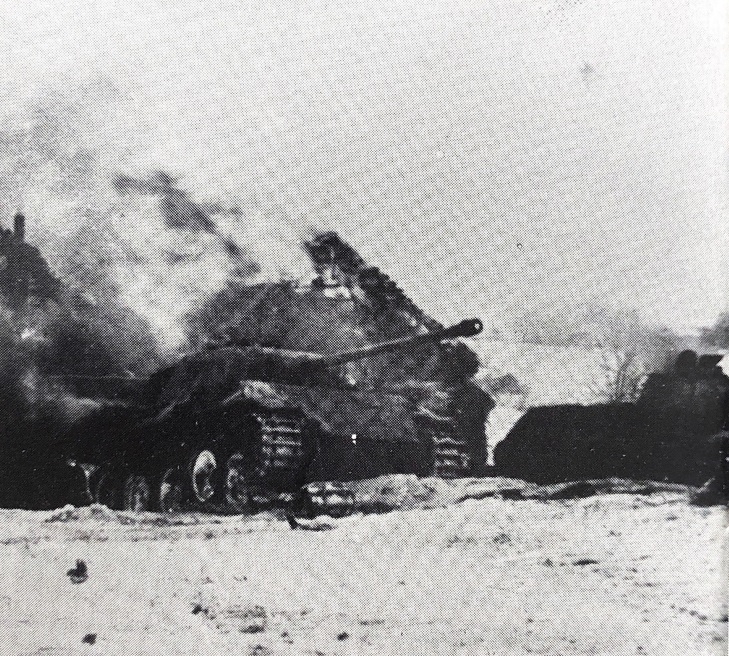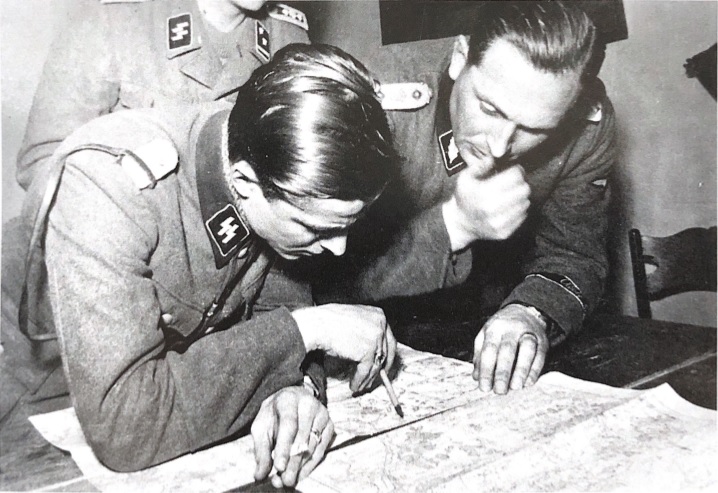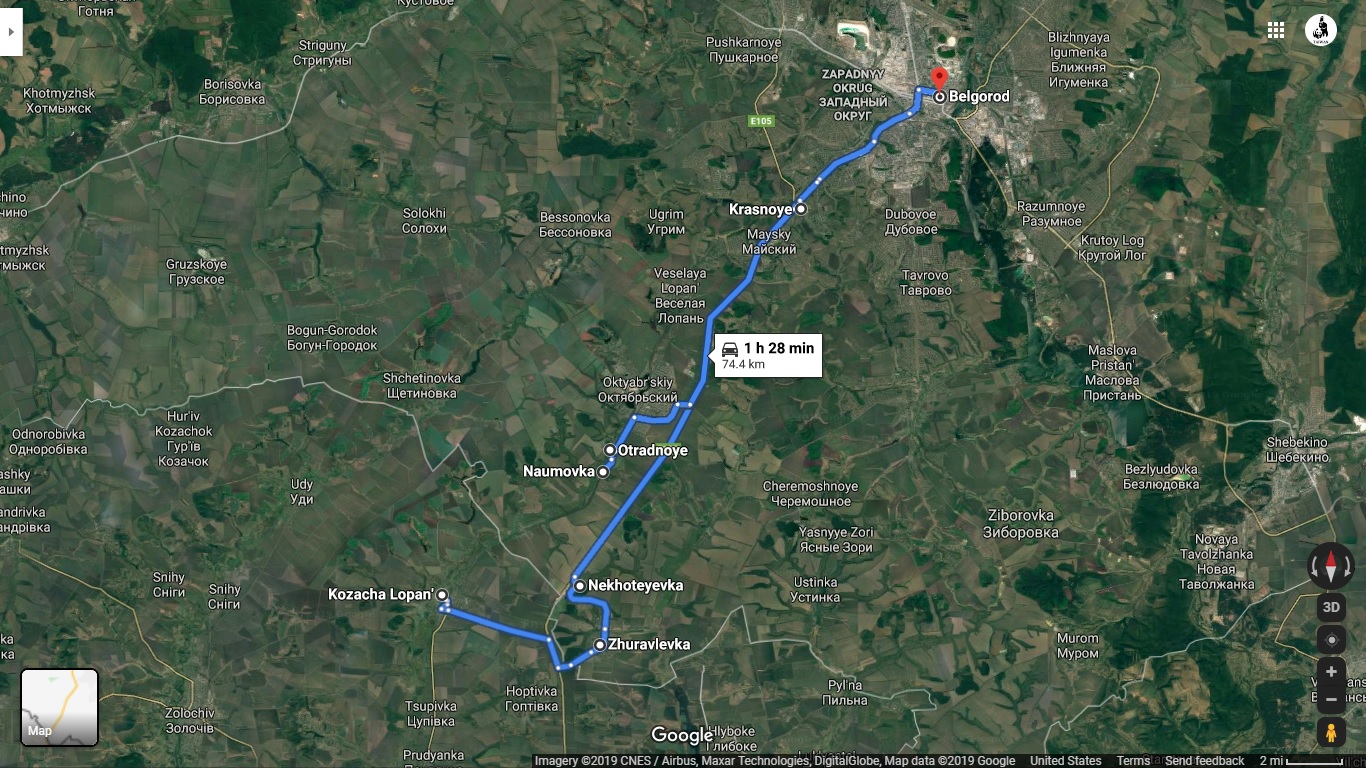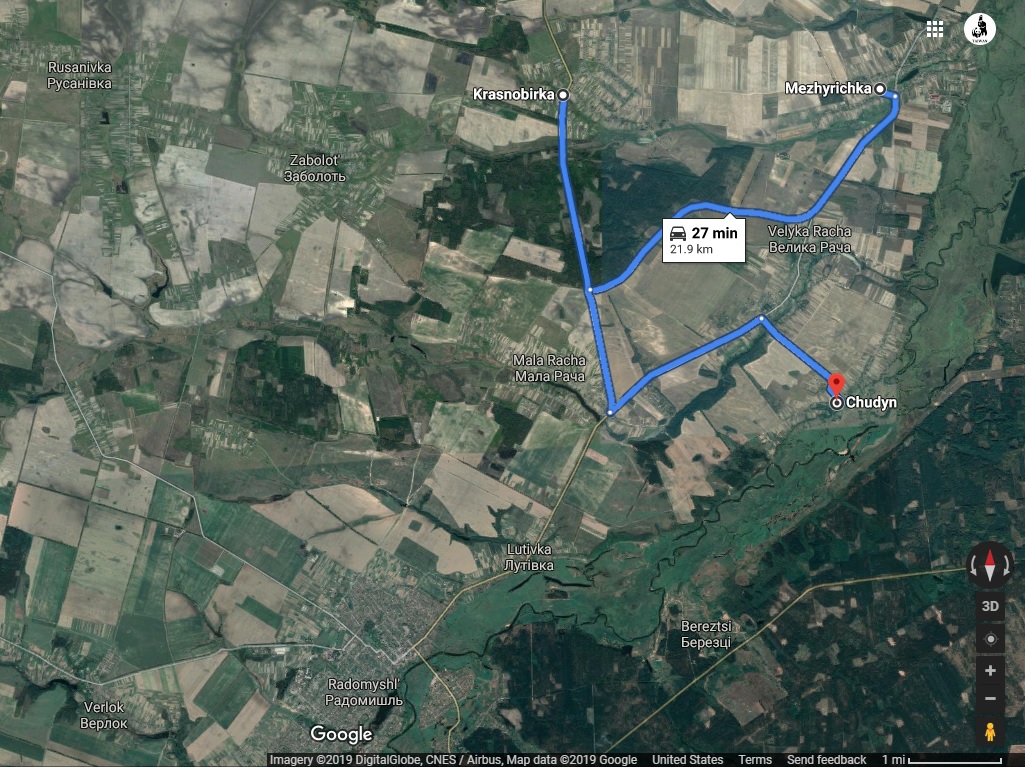The sky was overcast. The temperature was around zero degree. Light snowfall fell.1
During the night between 22nd and 23rd of December, the 226th Rifle Division reported that night passed quietly, with the exception of short fire raids from artillery and mortars, along its battle front facing the LSSAH.2
At 0345 hours, oddly, the SS-Panzergrenadier-Regiment 1 claimed that Hill 185.3, abandoned by the 8th Rifle Division in previous day, northeast of Meleni was attacked by a strong Soviet forces. The attack was eventually repulsed.3
At 0400 hours, in a report, the 175th Tank Brigade from the 25th Tank Corps acknowledged casualty of thirty-two killed and seventy-seven wounded as a result of fight in previous day. In addition, five tanks with crews from the 3rd Battalion of the Brigade were considered as missing in action.4
At 0430 hours, the 1. Panzer-Division claimed that its artillery and mortars were shelling recognized enemy provision distribution point in the area of Chopovychi station.5
By 0500 hours, as reinforcement, a force consists of fifteen T-34 tanks and two SU self-propelled guns of the 21st Guards Tank Brigade from the 5th Guards Tank Corps occupied its position 1 kilometer west of Chopovychi station. Later, the Brigade acknowledged suffering losses of three T-34 tanks – two were burned down and the rest of one was knocked out – during the battle, but allegedly destroyed two anti-tank guns, two machine gun nests, and up to twenty German soldiers in return.6
At 1145 hours, allegedly, two German tanks approaching to the positions of the 175th Tank Brigade were shot and burned by tank-fire.7
At 1230 hours, the 7. Panzer-Division started an attack with a Kampfgruppe from from Dobryn’ (Добринь) to Zabrane (Забране) in the south bank of Irsha River.8
At 1300 hours, allegedly, a German force of up to one battalion landed on fifteen vehicles went on the offensive against positions of the 226th Rifle Division nearby Hill 185.3 was repulsed.9
By 1400 hours, the elements of the 20th Motorized Rifle Brigade arrived the motor tractor station west of Chopovychi station, where the brigade went into defensive and stood by as the reinforcement of the 25th Tank Corps. It is noteworthy that during the three days fighting from 21st to 23rd of December, the brigade suffered casualty of two hundred and six killed and eight hundred and twenty-eight wounded. Aside from personnel losses, the brigade suffered equipment losses of one APC and one “Ford Model AA” truck.10
At 1400 hours, meanwhile, the 149th Rifle Division, reinforced by nine tanks from the 162nd Tank Brigade, went on attack towards Stremyhorod and the southern outskirts of Bolyarka.11
At 1425 hours, Guard Captain L. I. Avrutin, the deputy commander of the motorized submachine gunner battalion of the 175th Tank Brigade was seriously wounded. The battalion was holding its position 1.2 kilometers west of Chopovychi station.12
At 16:45 hours, Zabrane was allegedly taken by the 7th Panzer Division. The Soviets in the village put up only little resistance and evaded towards the northeastern direction.
At 1700 hours, the LSSAH reported that a Soviet force advancing on the Bolyarka station along the march route (geographically, it should be Korosten-Malin railway) was ambushed and routed by the I./SS-Panzergrenadier-Regiment 1, whose infantrymen mounted on the assault guns.13
At 1800 hours, however, the 568th Rifle Regiment of the 149th Rifle Division, reinforced by nine tanks from the 162nd Tank Brigade allegedly took possession of flour mill on the crossing of Hnidivka River, northeast of the village of Bolyarka. The advance allegedly was still in progress.14 15
At 1800 hours, meanwhile, nine T-34 tanks from the 1st Battalion of the 175th Tank Brigade launched attack towards the grove 2.5 kilometers west of Chopovychi station.16
At 1900 hours, 175th Tank Brigade reached the edge of the grove but acknowledged losses of three of T-34 tanks burned down during the fight.17 Aside from equipment, the brigade suffered casualty of thirty-five killed and fifty-one wounded as a result of fight during the day. In return, it allegedly eliminated Germans of five tanks, two Ferdinand tank destroyers, two armored personnel carriers, and up to one company of infantry in the battle.18
At 1900 hours, meanwhile, the 60th Army claimed that the Germans attacked the 8th Rifle Division along Zlobychi-Meleni road was repulsed by artillery and mortar fire. Four German tanks and up to one hundred and fifty German soldiers allegedly were eliminated as result of battle.19 Later, the 8th Rifle Division acknowledged that it suffered casualty up to one hundred and eighty-five killed and wounded in action during the day.20
Meanwhile, the 226th Rifle Division claimed that the Germans were thrown back to its starting position towards Lyplyany.21 Later, the 226th Rifle Division claimed inflicting losses of four tanks, four self-propelled guns, one APC and up to sixty soldiers upon the Germans, while acknowledged losses of seven machine guns, fifteen killed and thirty-two wounded in action during the day.22
At the same time, a few tanks of the 162nd Tank Brigade had allegedly crossed the Korosten-Malin railway, pushing towards Hill 187.2 located at 1 kilometer east of Bolyarka. The 25th Tank Corps later claimed that up to two battalions of German infantry, four tanks, eight guns, nine armored vehicles, fifteen vehicles, four mortars, one hundred carts and one hundred and twenty horses were destroyed as result of the fight in 23rd of December.23
In the course of the afternoon, the LSSAH reported that Soviet tanks had broken into the defensive area of the 291st Infanterie-Division from Khotynivka (Хотинівка) to the west of Stremyhorod. Four Soviet tanks were allegedly knocked down during the fighting. An intervention group consisting of tanks of the SS-Panzer-Regiment 1 temporarily stood on the highway southeast of the Bolyarka station to prevent further breakthrough.24 25
At nightfall, the LSSAH and the 1. Panzer-Division received order to assemble all combat-ready tanks in Sobolowka (Соболівка), starting at the first light of 24th of December to stand under disposal of the XLVIII. Panzerkorps. In the south, a new emerged crisis is calling the “fire brigade” to fulfill its own duty as usual. A new chapter unfolds slowly…
NOTES
- NARA T-314, R-1173, F-362. Tagesmeldung an Pz. A. O. K. 4., 1920 hours dated 23 Dec 43. ↩︎
- TsAMO, Fund. 1500, Inv. 1, File 9, Sheet 92. Doc. No. 112ОП. Combat report of 226th Rifle Division, 1500 hours dated 23 Dec 43. ↩︎
- NARA T-314, R-1173, F-359. Morgenmeldungen der Divisionen, 0430 hours dated 23 Dec 43. ↩︎
- TsAMO, Fund. 3238, Inv. 0000001, File 0017, Sheet 126. Doc. No. 102. Combat report of 175th Tank Brigade, 0400 hours dated 23 Dec 43. ↩︎
- NARA T-314, R-1173, F-359. Morgenmeldungen der Divisionen, 0430 hours dated 23 Dec 43. ↩︎
- TsAMO, Fund. 3099, Inv. 0000001, File 0004, Sheet 22. Combat report of 21st Guards Tank Brigade. ↩︎
- TsAMO, Fund. 3238, Inv. 0000001, File 0011, Sheet 28. Doc. No. 28. Combat report of 175th Tank Brigade. ↩︎
- NARA T-314, R-1173, F-362. Tagesmeldung an Pz. A. O. K. 4., 1920 hours dated 23 Dec 43. ↩︎
- TsAMO, Fund. 1500, Inv. 1, File 9, Sheet 92. Doc. No. 112ОП. Combat report of 226th Rifle Division, 1500 hours dated 23 Dec 43. ↩︎
- TsAMO, Fund. 3372, Inv. 0000001, File 0003, Sheet 285. Doc. No. 31. Operational report of 20th Motorized Rifle Brigade. ↩︎
- TsAMO, Fund. 1378, Inv. 1, File 53, Sheet 318. Combat report of 149th Rifle Division. ↩︎
- TsAMO, Fund. 3238, Inv. 0000001, File 0017, Sheet 130. Doc. No. 106. Combat report of 175th Tank Brigade, 0630 hours dated 23 Dec 43. ↩︎
- Rudolf Lehmann (1990). Leibstandarte III (p. 372). J.J. Fedorowicz Publishing. ↩︎
- TsAMO, Fund. 323, Inv. 4756, File 149, Sheet 50. Doc. No. 61. Combat report of 25th Tank Corps. ↩︎
- TsAMO, Fund. 1378, Inv. 1, File 53, Sheet 318. Combat report of 149th Rifle Division. ↩︎
- TsAMO, Fund. 3238, Inv. 0000001, File 0018, Sheet 8. Doc. No. 2/31. Combat report of 175th Tank Brigade. ↩︎
- TsAMO, Fund. 3238, Inv. 0000001, File 0011, Sheet 28. Doc. No. 28. Combat report of 175th Tank Brigade. ↩︎
- TsAMO, Fund. 3238, Inv. 0000001, File 0018, Sheet 8. Doc. No. 2/31. Combat report of 175th Tank Brigade. ↩︎
- TsAMO, Fund. 417, Inv. 10564, File 315, Sheet 202. Doc. No. 766. Combat report of 60th Army, 1900 hours dated 23 Dec 43. ↩︎
- TsAMO, Fund. 1062, Inv. 1, File 90, Sheet 73. Combat report of the 8th Rifle Division. ↩︎
- TsAMO, Fund. 417, Inv. 10564, File 315, Sheet 202. Doc. No. 766. Combat report of 60th Army, 1900 hours dated 23 Dec 43. ↩︎
- TsAMO, Fund. 1500, Inv. 1, File 9, Sheet 92. Doc. No. 112ОП. Combat report of 226th Rifle Division, 1500 hours dated 23 Dec 43. ↩︎
- TsAMO, Fund. 323, Inv. 4756, File 149, Sheet 50. Doc. No. 61. Combat report of 25th Tank Corps. ↩︎
- NARA T-314, R-1173, F-362. Tagesmeldung an Pz. A. O. K. 4., 1920 hours dated 23 Dec 43. ↩︎
- NARA T-314, R-1173, F-363. Ia Tagesmeldung, 1635 hours dated 23 Dec 43. ↩︎














![[燈] #改 7th (夜間) - 8th of December, Zhytomyr Oblast.](https://lavieillegarde.files.wordpress.com/2019/06/e78788-e694b9-7th-e5a49ce99693-8th-of-december-zhytomyr-oblast..jpg)
![[燈] 7th (夜間) Horodchyn Городчин 前往 Chodory的路上](https://lavieillegarde.files.wordpress.com/2019/06/e78788-7th-e5a49ce99693-horodchyn-d093d0bed180d0bed0b4d187d0b8d0bd-e5898de5be80-chodorye79a84e8b7afe4b88a.jpg)